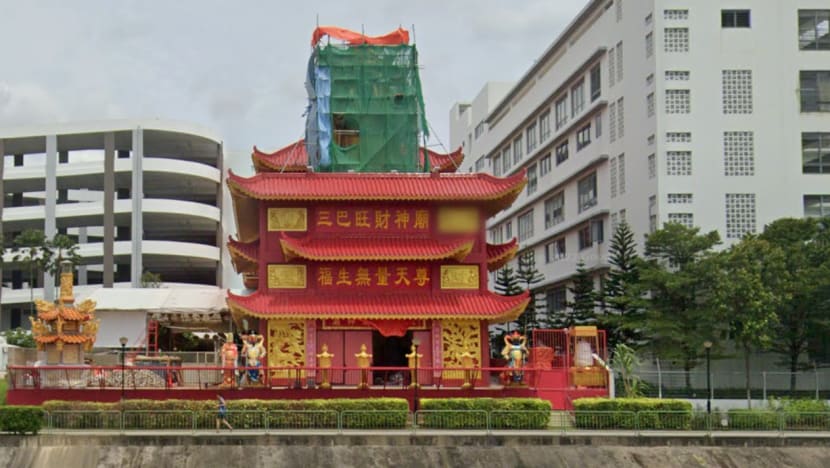Hornet nest likely went undetected for months before swarm fatally attacked cyclist: Coroner
The coroner said the nest, which was 12m up in a tree along the Sembawang Park Connector, had likely not been spotted earlier by an arborist and NParks contractors because it was not obvious to the naked eye.

The 60-year-old man was stung by multiple hornets while cycling near the Sembawang God of Wealth Temple. (Screengrab from Google Street View)

This audio is generated by an AI tool.
SINGAPORE: A hornet nest in a tree along the Sembawang Park Connector had likely existed for months when a swarm from a fallen fragment fatally attacked a cyclist, a coroner's court found on Friday (Sep 13).
An arborist and pest control contractors had likely missed the nest, as the main nest was 12m up in a tree near the Sembawang God of Wealth temple and well-camouflaged.
According to the family of the late Mr Ronnie Ang, the 60-year-old man enjoyed exercise, particularly cycling. His daughter said he cycled quite regularly, while his wife said he cycled along the park connector at least once every three weeks.
On Jul 4, 2022, Mr Ang had likely cycled past the tree shortly after part of the nest broke off and fell on the ground, said State Coroner Adam Nakhoda.
As a result, the hornets - which are usually not aggressive - went into a defensive or aggressive mode and stung Mr Ang.
Expert witnesses who testified at the inquiry suggested that the fragment may have broken off because it was attacked by a predator such as an oriental honey buzzard, a type of bird.
Mr Ang was covered with bites, with the toxin affecting his vital organs.
He was taken to hospital but died three days later with his final cause of death certified as multi-organ failure following an insect attack, with underlying ischaemic heart disease.
In his findings, the coroner said the medical care rendered to Mr Ang during his admission to Khoo Teck Puat Hospital (KTPH) was "reasonable".
However, he said KTPH had acknowledged in a letter to Mr Ang's daughter that communication with the family "could have been better".
"I would urge hospitals to have ... (timely) communication to the next-of-kin, especially in critical events," said the coroner.
The initial diagnoses of Mr Ang's condition was anaphylaxis, which is a life-threatening allergic reaction. But this was later proven false, as clinical evidence did not support this conclusion.
He did not show any clinical signs of allergy, such as a swollen tongue, lips or eyes. However, he was also treated for an allergic reaction with medicines such as antihistamines.
When Mr Ang's first blood test came back and revealed raised inflammatory cardiac, liver and kidney markers, it was reflective of respiratory failure, and the medical team began treatment to support his liver and kidney issues.
Despite this, his condition worsened and he died on the morning of Jul 7, 2022 after being transitioned to "comfort care" in view of medical futility.
A specialist testified that there was no general antidote to counter insect venom, and no toxicology test available to identify which insect the venom is from.
THE HORNET NEST
The coroner said it was not possible to determine the age of the nest, but an expert report suggested it was approximately five to eight months old, based on its size.
If this was the case, the nest would have been in the tree sometime from November 2021 to February 2022, or was built during that time, said the coroner.
He said it was possible that the nest was already there when a National Parks Board (NParks) arborist did an inspection in March 2022. The arborist had not indicated seeing a hornet's nest.
NParks contractors also did not detect the nest on two other occasions in May and June 2022.
During the six months before the incident, there was one report of a "bee" sighting - in early June 2022.
NParks activated pest control that same day to check on the trees and canopies near the temple for a bee or hornet nest, but none was found.
NParks officers also carried out an inspection on trees along the park connector on Jun 7 and Jun 9, 2022, but found no bee or hornet activity or any nest.
The coroner said it was likely that the arborist and contractors did not see the nest because it was not immediately obvious.
It was 12m high up in the tree, and likely to be camouflaged in the canopy and obscured by branches.
An expert testified that hornet nests can blend in well with the surrounding vegetation and tree bark and may not be easily spotted by the naked eye.
This was emphasised by the fact that when other pest control contractors were engaged on Jul 5, 2022, after reports from the public requesting the removal of nest remnants from the ground, the contractors did not spot what remained of the nest 12m up in the tree.
It was only two days later that they finally spotted the last part of the nest. They then destroyed the hornets found in the nest and removed the remaining portion.
A different nest on a different tree was also later removed.
Citing the expert, the coroner said there is no reliable way to prevent hornets from nesting. They do not restrict nest-building to certain types of trees, and can build their nests anywhere.
If a member of the public spots a bee or hornet nest, they should "clearly refrain" from approaching the nest.
Instead, they could call NParks as soon as possible to report the sighting.
The coroner ruled Mr Ang's death a tragic misadventure and conveyed his condolences to Mr Ang's wife and daughter, who were at the hearing and could be seen wiping away their tears during the findings.














